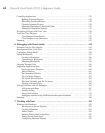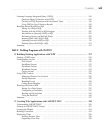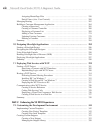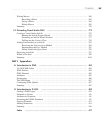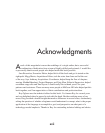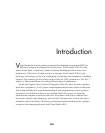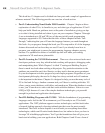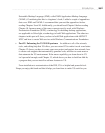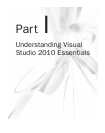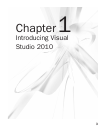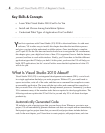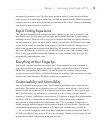
xx Microsoft Visual Studio 2010: A Beginner’s Guide
This book has 13 chapters and is divided into four parts and a couple of appendixes as
reference material. The following provides an overview of each section:
● Part I: Understanding Visual Studio 2010 Essentials Chapter 1 begins with an
explanation of what VS is, its benefits to you, and what type of applications VS will
help you build. Hands-on guidance starts at the point of installation, giving you tips
as to what is being installed and where it goes on your computer. Chapters 2 through
4 are an introduction to C# and VB, two of the most widely used programming
languages supported in VS. Notice that the titles of these chapters include “Just
Enough,” indicating that you will learn the language features you need throughout
this book. As you progress through the book, you’ll be exposed to all of the language
features discussed and see how they are used. Even if you already know how to
program, you might want to peruse the programming language chapters anyway
because I’ve sprinkled in dozens of valuable tips that will make your coding
experience in VS much more pleasurable.
● Part II: Learning the VS 2010 Environment There are a few universal tasks most
developers perform every day, which include working with projects, debugging code,
and manipulating data. While Chapter 5 is titled “Creating and Building Projects,”
there is much involved when working with projects. Pay particular attention to the
guidance on assemblies and class libraries, as they tend to become more prominent
as your development activities progress beyond simple programs. Regardless of your
development philosophy, the need to fix bugs has always existed and will continue
to be important in the future. Chapter 6 is designed to help you use the many tools of
VS to find and fix bugs. Another common task you’ll have is working with data. VS
allows you to create databases, add tables, and much more. When the database is ready
to use, you’ll learn how to write code that works with the database. I chose to cover
LINQ to SQL because it’s one of the simpler database technologies, yet powerful
enough for professional application development.
● Part III: Building Programs with VS 2010 With the foundations of programming
languages and a feel for the VS environment, you’ll be ready to use VS to build
applications. The .NET platform supports various technologies, and this book takes
a forward-looking approach, choosing technologies that were the most recently
introduced. The focus in these chapters is not to teach you everything about these
technologies, which can fill entire books themselves, but rather to show you how to
leverage VS in building applications. You’ll get the foundations that will give you a
head start in building your own applications. Both Chapters 8 and 10 use a form of



